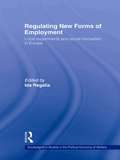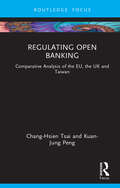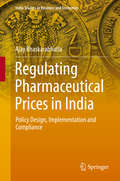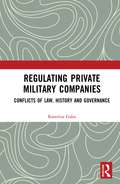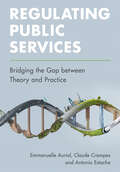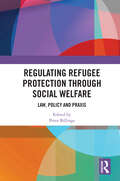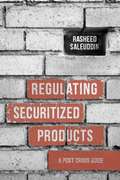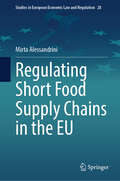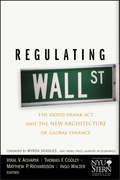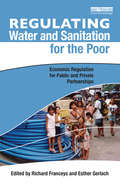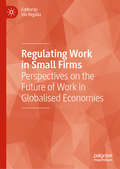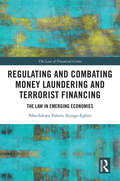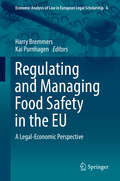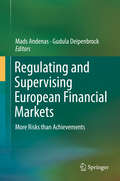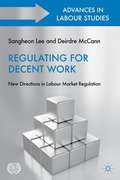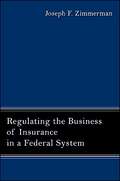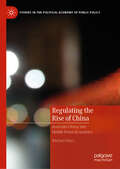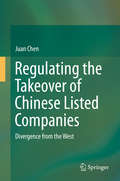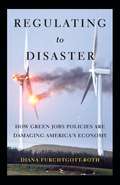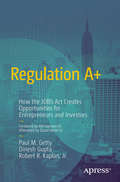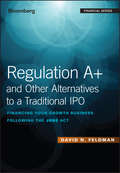- Table View
- List View
Regulating New Forms of Employment: Local Experiments and Social Innovation in Europe (Routledge Studies in the Political Economy of the Welfare State)
by Ida RegaliaUsing a comparative framework, this new volume focuses on how non-standard employment can be regulated in very different social, political and institutional settings. After surveying these new forms of work and the new demands for labour-market regulation, the authors identify possible solutions among local-level actors and provide a detailed analysis of how firms assess the advantages and disadvantages of flexible forms of employment. The authors provide six detailed case studies to examine the successes and failures of experimental approaches and social innovation in various regions in the UK, France, Germany, Italy and Spain.
Regulating Open Banking: Comparative Analysis of the EU, the UK and Taiwan (Routledge Research in Finance and Banking Law)
by Chang-Hsien Tsai Kuan-Jung PengFinTech transformations have brought changes to the global financial markets and merit the attention of financial regulators across jurisdictions. This book is one of the first ones of its kind to look at open banking (OB). It examines regulatory approaches to OB by taking a broad view of comparative legal systems and through perspectives of transaction costs, public choice, and institutional design. The book looks at the legal implications by engaging in a two-tiered comparative analysis: comparing between compulsory and voluntary approaches to OB policies and comparing the legal systems between the West (i.e., the EU and the UK) and an Asian economy (i.e., Taiwan).
Regulating Pharmaceutical Prices in India: Policy Design, Implementation And Compliance (India Studies in Business and Economics)
by Ajay BhaskarabhatlaThis book presents an extensive study on the effectiveness of recent regulations on pharmaceutical prices in India, exploring the weaknesses in the design and implementation of pharmaceutical price controls and investigating what can be done to fix the broken system.In addition, it examines the extent to which essential medicines are actually made affordable by price controls. The book argues that companies make the pharmaceutical price control regime largely ineffective by coordinating to increase pre-regulation prices; by diversifying horizontally away from the regulated markets and increasing prices in the unregulated markets; by manipulating trade margins; and by refusing to comply with the regulation because the penalties remains negligible.The book draws on extensive empirical research involving India’s 2013 Drug Price Control Order and widely-used medicines such as paracetamol and metformin to illustrate how firms have weakened regulation. It argues that the regulatory regime can be strengthened by using systematic analysis of product- and region-level data in the Indian pharmaceutical industry, and by screening for the strategies that firms currently employ to circumvent regulation. In closing, it discusses recent efforts to strengthen the implementation of price controls in India and expanding the scope of price controls to medical devices.
Regulating Private Military Companies: Conflicts of Law, History and Governance
by Katerina GalaiThis work examines the ability of existing and evolving PMC regulation to adequately control private force, and it challenges the capacity of international law to deliver accountability in the event of private military company (PMC) misconduct. From medieval to early modern history, private soldiers dominated the military realm and were fundamental to the waging of wars until the rise of a national citizen army. Today, PMCs are again a significant force, performing various security, logistics, and strategy functions across the world. Unlike mercenaries or any other form of irregular force, PMCs acquired a corporate legal personality, a legitimising status that alters the governance model of today. Drawing on historical examples of different forms of governance, the relationship between neoliberal states and private military companies is conceptualised here as a form of a ‘shared governance'. It reflects states’ reliance on PMCs relinquishing a degree of their power and transferring certain functions to the private sector. As non-state actors grow in authority, wielding power, and making claims to legitimacy through self-regulation, other sources of law also become imaginable and relevant to enact regulation and invoke responsibility.
Regulating Public Services: Bridging the Gap between Theory and Practice
by Antonio Estache Emmanuelle Auriol Claude CrampesRegulation is one of the tools used by governments to control monopolistic behaviour in the provision of public services such as electricity, transport or water. Technological and financial innovations have changed these public services markets since the 1990s, bringing new regulatory challenges, including technological and financial ones. This book demonstrates that basic regulatory theory and tools can address these new challenges, in addition to more traditional regulatory issues, both in developed and developing economies. The theory covered in the book is robust enough to guide regulators in multiple contexts, including those resulting from the effects of financial or political constraints, evolving market structures or the need to adapt to institutional weaknesses, climate change and poverty concerns that demand regulatory intervention. A bridge between theory and an evolving global practice, this book mobilizes the lessons of the past to analyse the future of economic regulation.
Regulating Radio in the Age of Broadcasting
by David A. Moss Colin Donovan Marc CampasanoWhen the Titanic tragically sank on April 15, 1912, potentially life-saving help was delayed as a result of failures in radio communication. In part as a result, Congress moved swiftly to regulate radio, passing the Radio Act of 1912 four months later. Although at this stage radio was still used principally for point-to-point, Morse code communications, the radio scene changed drastically in the early 1920s with the rise of broadcasting, as new private stations began to deliver music and voice programs to a listening public. By 1927, more than 700 stations were battling over 96 available frequencies. This crowding of the broadcast spectrum substantially diminished the quality of radio listening. In fact, the airwaves were so full of interference that many citizens complained that it was often impossible to tune into any station clearly. In January 1926, both houses of Congress began considering sweeping bills to tackle the problem of interference and the question of how to allocate frequencies for broadcasting. Lawmakers vigorously debated a broad set of issues, ranging from questions of ownership and regulatory authority to the protection of free speech and the prevention of monopoly. A bill endorsed by both the House and Senate emerged a little over a year later, after the interference problem was said to have grown worse, and it finally arrived on the desk of President Calvin Coolidge on February 23, 1927. The bill would create a Federal Radio Commission with the power to license radio stations for two years at a time. President Coolidge had endorsed radio reform in his most recent annual message to Congress but had requested that all regulatory power be granted to the secretary of commerce, not to a commission. Now, with Congress having opted for a commission, he had to decide if the bill before him charted an acceptable path for American radio regulation.
Regulating Refugee Protection Through Social Welfare: Law, Policy and Praxis
by Peter BillingsThis book analyses the use and abuse of social welfare as a means of border control for asylum seekers and refugees in Australia. Offering an unparalleled critique of the regulation and deterrence of protection seekers via the denial or depletion of social welfare supports, the book includes contributions from legal scholars, social scientists, behavioural scientists, and philosophers, in tandem with the critical insights and knowledge supplied by refugees. It is organised in three parts, each framed by a commentary that serves as an introduction, as well as offering pertinent comparative perspectives from Europe. Part One comprises three chapters: a rights-based analysis of Australia’s ‘hostile environment’ for protection seekers; a searing critique of welfare policing of asylum seekers as ‘necropolitics’; and a unique philosophical perspective that grounds scrutiny of Australia’s policing of asylum seekers. Part Two contains five chapters that uncover and explore the lived experiences and adverse impacts of different social welfare restrictions for refugee protection seekers. Finally, the chapters in Part Three offer distinct views on human rights advocacy movements and methods, and the scope for resistance and change to the status quo. This book will appeal to an international, as well as an Australian, readership with interests in the areas of human rights, immigration and refugee law, social welfare law/policy, social work, and public health.
Regulating Securitized Products
by Rasheed SaleuddinSecuritization regulation remains, in the eyes of investors, banks, businesses, bureaucrats and politicians, one of the remaining unsolved puzzles of the post-Global Financial Crisis landscape. This book describes the key features of securitization, including the most common structures and their uses as well as the motivations of the participants in these markets. Important historical moments and case studies are frequently used to illustrate critical issues in the design and enforcement of regulation for securitized products. This work is intended to contextualize and contribute to the highly specialized debates between policymakers, regulators and the regulated financial intermediaries, setting out an agenda for discussion as well as providing some strongly held views on possible solutions. Written by an industry insider with over 20 years' experience in the markets, this book considers regulatory tools from all sides while avoiding common biases. It is a valuable source for not only regulators and policymakers, but also educators, students and researchers in financial regulation, financial engineering and investment management.
Regulating Short Food Supply Chains in the EU (Studies in European Economic Law and Regulation #28)
by Mirta AlessandriniThis volume presents a thorough analysis of the concept and role of Short Food Supply Chains (SFSCs) within the EU legal framework with a two-fold aim: first, it shows the pitfalls of the current legal scenario, which often limits alternatives rather than promoting them, and second, it provides a new conceptualisation for SFSCs under EU law by delineating and integrating all their distinctive features. Agricultural landscapes in the EU are now undergoing fundamental changes, revealing an increasing interest in SFSCs as a tool for promoting both local products and their food systems. Despite being the backbone of the EU agricultural system, SFSCs’ position in the current socioeconomic narrative has not been sufficiently fostered. In response, the book traces how SFSCs have historically been dealt with under the agricultural rules of the CAP, and to a much lesser extent, those relating to internal market food law, delving into the intricate relationship between agricultural and food law. The integration of these two disciplines into an agri-food law domain represented a pivotal shift in legal discourse, in particular in the context of SFSC regulation. The legal analysis extends its scope to encompass spatial and historical dimensions, enriching the contextual understanding of regulatory frameworks over time and across geographical boundaries. This new conceptualisation does not aim to establish a universal, ‘set-in-the-stone’ legal definition for SFSC applicable across disciplines. Rather, it seeks to identify common themes and key features among various SFSC initiatives. These themes serve as the foundation for determining a set of minimum legal requirements for the recognition and valorisation of SFSC initiatives at the EU level, which Member States can then tailor to their specific needs. The goal is to lay the groundwork for developing a concept that can be effectively operationalised across different sectors and geographical dimensions. The book makes a substantial contribution to the current academic debate, filling a significant gap in the existing CAP literature. On the one hand, it provides the first comprehensive and systematic analysis of all the measures that have addressed small farmers and SFSCs, from the CAP reforms up to the present day. On the other, by adopting a new multidisciplinary perspective encompassing legal, sociological, and agri-food studies, it raises new questions on the role of short supply chains in light of the Farm to Fork Strategy and beyond.
Regulating Wall Street
by Viral V. Acharya New York University Stern School of Business Matthew P. Richardson Myron Scholes Ingo Walter Thomas F. CooleyExperts from NYU Stern School of Business analyze new financial regulations and what they mean for the economyThe NYU Stern School of Business is one of the top business schools in the world thanks to the leading academics, researchers, and provocative thinkers who call it home. In Regulating Wall Street: The New Architecture of Global Finance, an impressive group of the Stern school's top authorities on finance combine their expertise in capital markets, risk management, banking, and derivatives to assess the strengths and weaknesses of new regulations in response to the recent global financial crisis.Summarizes key issues that regulatory reform should addressEvaluates the key components of regulatory reformProvides analysis of how the reforms will affect financial firms and markets, as well as the real economyThe U.S. Congress is on track to complete the most significant changes in financial regulation since the 1930s. Regulating Wall Street: The New Architecture of Global Finance discusses the impact these news laws will have on the U.S. and global financial architecture.
Regulating Water Security in Unconventional Oil and Gas (Water Security in a New World)
by Chad Staddon Regina M. Buono Elena López Gunn Jennifer McKayThis book addresses the need for deeper understanding of regulatory and policy regimes around the world in relation to the use of water for the production of ‘unconventional’ hydrocarbons, including shale gas, coal bed methane and tight oil, through hydraulic fracturing. Legal, policy, political and regulatory issues surrounding the use of water for hydraulic fracturing are present at every stage of operations. Operators and regulators must understand the legal, political and hydrological contexts of their surroundings, procure water for use in the fracturing and extraction processes, gain community cooperation or confront social resistance around water, collect flow back and produced water, and dispose of these wastewaters safely. By analysing and comparing different approaches to these issues from around the globe, this volume gleans insights into how policy, best practices and regulation may be developed to advance the interests of all stakeholders. While it is not always possible to easily transfer ‘good practice’ from one place to another, there is value in examining and understanding the components of different legal and regulatory regimes, as these may assist in the development of better regulatory law and policy for the rapidly growing unconventional energy sector.The book takes an interdisciplinary approach and includes chapters looking at water-energy nexus security in general, along with issue-focused and geographically-focused case studies written by scholars from around the world.Chapter topics, organized in conjunction with the stage of the shale gas production process upon which they touch, include the implications of hydraulic fracturing for agriculture, municipalities, and other stakeholders competing for water supplies; public opinion regarding use of water for hydraulic fracturing; potential conflicts between hydraulic fracturing and water as a human right; prevention of induced seismic activity, and the disposal or recycling of produced water. Several chapters also discuss implications of unconventional energy production for indigenous communities, particularly as regards sustainable water management. This volume will be of interest to scholars and students of energy and water, regulators and policymakers and operators interested in ensuring that they align with emergent best global practice.
Regulating Water and Sanitation for the Poor: Economic Regulation for Public and Private Partnerships
by Richard Franceys Esther GerlachThe aim of this book is to present the potential benefits as well as the challenges of introducing a more formal economic regulatory process into the urban water sector arena in lower-income countries. There is a particular focus upon the impact this may have on the poorest, the informal, slum and shanty dwellers of the rapidly growing cities. Economic regulation, usually introduced in the context of private operation of monopoly water supply, can deliver objectivity and transparency in the price-setting process for public as well as private providers. The book describes and analyses these issues through a consideration of ten country case studies. As a starting point, the current situation for the provision of water and sanitation services for the poorest through non-regulated public providers in India and Uganda is reviewed. Comparative chapters are then presented on Ghana, Philippines, Bolivia, Jordan, Zambia and Indonesia, all with varying degrees of private sector involvement and regulation. Finally the experiences of two richer countries are considered - Chile and England, countries with the longest experience of economic regulation and the 'most privatized' suppliers. In all cases there is a focus on the very necessary role of customer involvement in price-setting and service monitoring and on the role of alternative (private) service providers.
Regulating Work in Small Firms: Perspectives on the Future of Work in Globalised Economies
by Ida RegaliaExploring the diversity of small firms, this contributed volume focuses on the crucial topic of work and the ways in which it is regulated, and offers reflections on the future of labour more generally. Traditionally managed through informal and adaptive processes, small firms allow us to understand the challenges and opportunities facing larger companies within an increasingly fragmented global production system. Analysing the case of Italy, a country characterised by a high number and wide variety of small firms, the authors draw on the results of a survey involving over 2,300 firms and face-to-face interviews with owner-managers working in 60 small and micro firms across several different sectors. Providing detailed analysis which will be useful for scholars of human resource management and small business, as well as managers, practitioners and policy-makers, the book enables a better understanding of the world of work in a globalised economy.
Regulating and Combating Money Laundering and Terrorist Financing: The Law in Emerging Economies (The Law of Financial Crime)
by Nkechikwu Valerie AzingeThis book analytically reviews the impact of the global anti-money laundering and counter-terrorist financing (AML/CFT) framework on the compliance trajectory of a number of jurisdictions to this framework. The work begins by examining the international financial sector reform and its evolution to inculcate the global framework for AML/CFT regulations. It challenges the resulting uniform AML/CFT due to its paradoxical impact on the compliance trajectory of African countries and emerging economies (ACs/EEs). This is done through an examination of the pre-conditions for effective regulation and compliance drivers for ACs/EEs that reveals the behavioural impact of the AML/CFT standards on the bloc of countries. Through the application of agency theory, it explores the relationship between ACs/EEs on the one hand and the international financial institutions that formulate, disseminate and facilitate compliance with the global framework for AML/CFT standards on the other. The remaining chapters review empirically the compliance pressures and resulting compliance trajectory of ACs/EEs with the AML/CFT standards. The final part of the book provides a detailed explanation of the compliance challenges of ACs/EEs and the legitimacy concerns that facilitate this. This book offers a new direction on the impact of global AML/CFT standards on ACs/EEs and contributes to the understanding of the conditions under which the global standards are likely to facilitate proactive compliance within these blocs of countries. As such it will be a valuable resource for academics, researchers and policy-makers working in this area.
Regulating and Managing Food Safety in the EU: A Legal-Economic Perspective (Economic Analysis of Law in European Legal Scholarship #6)
by Kai Purnhagen Harry BremmersThis book analyses EU food law from a regulatory, economic and managerial perspective. It presents an economic assessment of strategies of food safety regulation, and discusses the different regulatory regimes in EU food law. It examines the challenges of food safety in the internal market as well as the regulatory tools that are available. The book’s generic theorising and measurement of regulatory effects is supplemented by detailed analysis of key topics in food markets, such as health claims, enforcement strategies, and induced risk management at the level of the organizations producing food. The regulatory effects discussed in the book range from classical regulatory analysis covering e.g. effects of ex-ante versus ex-post regulation and content-related versus information-related regulation to new regulatory options such as behavioral regulation. The book takes as its premise the idea that economic considerations are basic to the design and functioning of the European food supply arena, and that economic effects consolidate or induce modification of the present legal structures and principles. The assessments, analyses and examination of the various issues presented in the book serve to answer the question of how economic theory and practice can explain and enhance the shaping and modification of the regulatory framework that fosters safe and sustainable food supply chains.
Regulating and Supervising European Financial Markets
by Mads Andenas Gudula DeipenbrockThe book analyses the institutions of the European financial market supervision and the challenges of financial markets. The current European supervisory structure for financial markets represents a major development in European supervisory history. Its operation however has to be explored and analysed critically. Has it gone far enough to provide a sufficiently comprehensive and resilient system to reduce or mitigate systemic risks and handle financial crises? Some claim it has gone too far already. Fresh and rigorous critical legal and economic analysis from an independent scholarly perspective are needed to assess whether the institutional design of the European supervisory architecture has proved itself to be an efficient and effective model. This book discusses many dimensions of the structure and workings of the European system from various angles providing different dimensions. The book makes an important contribution to the limited literature on financial market supervision.
Regulating for Decent Work
by Sangheon Lee Deirdre MccannRegulating for Decent Work is an international and interdisciplinary response to the neoliberal ideologies that have shaped labor market regulation in recent decades. It draws on contributions by leading experts across a range of disciplines including economics, law, political science, and industrial relations. International in scope, it includes chapters on advanced economies (Canada, Europe, the United States) and the developing world (Brazil, China, Indonesia, Tanzania). The volume identifies central themes in the contemporary regulation of labor, including the role of empirical research in assessing and supporting labor market interventions, the regulation of precarious work, and the emergence of new types of labor markets. Chapters cover issues such as labor market uncertainty, the effectiveness of legal norms, and methodologies for evaluating the intersection of various levels of regulation. "Regulating the labor market is a distortion for some, a panacea for others. This book provides the ingredients for those who wish to transcend simple positions. . . . It is a significant resource for scholars and policymakers who are engaged in thinking about regulation as part of a just market regime. "--Guy Mundlak
Regulating the British Economy, 1660–1850
by Perry GauciThis collection of chapters focuses on the regulation of the British economy in the long eighteenth century as a means to understand the synergies between political, social and economic change as Britain was transformed into a global power. Inspired by recent research on consumerism and credit, an international team of leading academics examine the ways in which state and society both advanced and responded to fundamental economic changes. The studies embrace all aspects of the regulatory process, from developing ideas on the economy, to the passage of legislation, and to the negotiation of economic policy and change in practice. They range broadly over Britain and its empire and also consider Britain's exceptionality through comparative studies. Together, the book challenges the general characterization of the period as a shift from a regulated economy to a more laissez-faire system, highlighting the uncertain relationship between the state and economic interests across the long eighteenth century.
Regulating the Business of Insurance in a Federal System
by Joseph F. ZimmermanIn Regulating the Business of Insurance in a Federal System, Joseph F. Zimmerman provides an up-to-date historical description and analysis of the regulation of the business of insurance in the United States. He focuses on the controversial issue of whether Congress should authorize optional federal charters for insurance companies, thereby establishing a dual charter system superficially similar to the dual banking system. Reviewing the evidence between federal and state level regulation of the financial securities industry, Zimmerman finds that federal regulation falls woefully short of its state counterpart. He concludes that the current system, rather than the proposed dual insurance regulatory system, is the most efficient and effective.
Regulating the Collaborative Economy in the European Union Digital Single Market
by Marco IngleseThis book critically assesses how the rise of the collaborative economy in the European Union Digital Single Market is disrupting consolidated legal acquisitions, such as classical internal market categories, as well as the applicability of consumer protection, data protection, and labour and competition law. It argues that the collaborative economy will, sooner or later, require some sort of regulatory intervention from the European Union. This regulatory intervention, far from stifling innovation, will benefit online platforms, service providers and users by providing them with a clearer and more predictable environment in which to conduct their business. Although primarily intended for academics, this book also appeals to a wider readership, including, but not limited to, national and international regulators, private firms and lobbies as well as online platforms, consumer associations and trade unions.
Regulating the Rise of China: Australia’s Foray into Middle Power Economics (Studies in the Political Economy of Public Policy)
by Michael PetersThis book revises the existing account of the first Rudd Government's engagement with China, placing Australian foreign direct investment screening policy at the centre of the story. At the time, the Rudd Government was accused of holding an unnecessarily interventionist approach to Chinese Sovereign-Owned Enterprise investments into the Australian mining sector. This book claims that the Australian Government had a deep and coherent understanding of the problem posed by Chinese investments that went well-beyond any simplistic 'China Inc.' or geopolitical threats. The key policymakers believed that the Chinese state-directed investments threatened the integrity of the liberal governance structures on which the Australian state is founded, and so Australian sovereignty itself. While the response of the Rudd Government was largely ineffectual, the logic underpinning it remains the best framework for guiding Australia's engagement with China into the 2020s, as well as the engagement of other liberal states coming to grips with China's rise.
Regulating the Takeover of Chinese Listed Companies
by Juan ChenThis book provides a comprehensive review of the Measures for Administration of Takeover of Chinese Listed Companies (the Chinese takeover law), with emphasis on the differences between the Chinese takeover law and takeover legislation in the UK, the US and Hong Kong. The Chinese M&A market has been booming at an unprecedented rate in recent years; not only domestic investors, but also foreign funds and multinational companies are actively participating on the market. For both market participants and researchers, it is crucial to understand the emerging and transitional aspects of the Chinese economy and its M&A market, and the impacts of those aspects on relevant laws. While there are ongoing academic discussions on the convergence between the Chinese takeover law and its counterparts in the UK, Hong Kong and the US, this book offers a comprehensive discussion of the divergence and focuses on key differences in the transplanted Chinese takeover law.
Regulating to Disaster
by Diana Furchtgott-RothWhat is a "green job" anyway? Few can adequately define one. Even the government isn't sure, you will learn in these pages. Still, President Obama and environmentalist coalitions such as the BlueGreen Alliance claim the creation of green jobs can save America's economy, and are worth taxpayers' investment.But in Regulating to Disaster, Diana Furchtgott-Roth debunks that myth. Instead, energy prices rise dramatically and America's economic growth and employment rate suffer - in some states much more than others - when government invests in nonviable ventures such as the bankrupted Solyndra, which the Obama Administration propped up far too long.Electric cars, solar energy, wind farms, biofuels: President Obama's insistence on these dubious pursuits ultimately hamstrings American businesses not deemed green enough, and squeezes struggling households with regulations. Adding insult to injury: the technology subsidies Americans pay for solar panels, wind turbines, and electric batteries really help create manufacturing jobs in China and South Korea.Green jobs are the most recent reappearance of a perennial bad idea - government regulation of certain industries, designed to anoint winners and losers in the marketplace. Regulating to Disaster reveals the powerful nexus of union leaders, environmentalists, and lobbyists who dreamed up these hoaxes, and benefit politically and financially from green jobs policies. Unfortunately, there are more Solyndras on the horizon, and our economy is in no shape to absorb them.
Regulation A+
by Paul M. Getty Dinesh Gupta Robert R. Kaplan"This book is a must-read for all entrepreneurs who need to raise capital to grow their businesses. " --from the Foreword by Bill Hambrecht, Founder and Chairman, WR Hambrecht + Co "We congratulate the authors for bringing together many of the elements needed to help corporations and their investors take advantage of Reg A+ in a simple and easy-to-understand guide. " --from the Afterword by David Weild IV, Founder and CEO, Weild & Co. ; Former Vice Chairman of NASDAQ; "Father" of the JOBS Act Discover how to raise money under the SEC''s long-awaited Regulation A+ implementing Title IV of the JOBS Act. This ground-breaking book is the authoritative guide to Reg A+ for executives of emerging growth companies, entrepreneurs, financial advisers, venture capitalists, investment bankers, securities lawyers, and finance and MBA students on how to raise up to $50 million a year through what is in effect a new type of IPO unencumbered by the heavy regulation and cost of a traditional IPO. Reg A+ lifts many of the constraints on soliciting funds, raising growth capital through public offerings, and trading new stock issues that till now inhibited the growth of small companies. The SEC rules implementing Title III of the JOBS Act by expanding equity crowdfunding to non-accredited investors and allowing small businesses to raise up to $1 million per year have been greeted with speculative excitement in the startup space. But investment banking and stock market heavy hitters such as Bill Hambrecht and David Weild believe that Reg A+ will have a much greater economic impact than the crowdfunding rules and will launch a revolutionary period of growth, innovation, investment returns, and job creation. Paul Getty, Dinesh Gupta, and Robert Kaplan pool their experience as serial entrepreneurs, investors, and lawyers to show readers in very practical terms how to take maximum advantage of the powerful provisions of the Reg A+ that permit companies to raise up to $50 million--a tenfold increase over the old Reg A limit of $5 million and fifty times the crowdfunding limit allow companies to market IPOs to more people than just accredited investors make it easier to get the word out on offerings exempt companies under certain conditions from onerous and costly reporting and compliance requirements, such as Sarbanes-Oxley What you''ll learn How Title IV of the JOBS Act amends Regulation A, making it easier for you to raise up to $50 million in expansion capital while avoiding burdensome regulations. How raising funds through Regulation A might now be a better and less costly choice for raising capital than current options (like loans or venture capital). How to use Regulation A to gain liquidity for your business, your employees, and your investors--while maintaining control. How to abide by Regulation A rules before, during, and after an IPO. What kinds of businesses can take part in Regulation A offerings. How and where to trade shares after the IPO. Who this book is for Executives of emerging growth companies, entrepreneurs, financial advisers, venture capitalists, investment bankers, securities lawyers, finance and MBA students, and others. Table of Contents Chapter 1 Introduction Chapter 2 Overcoming Challenges to Going Public Chapter 3 Benefits of Regulation A+ Chapter 4 Limitations and Business Line Considerations Chapter 5 The Key Elements of a Reg A+ Offering Chapter 6 Raising the Capital through an Underwriter Chapter 7 Post-IPO Activities Chapter 8 Secondary Markets and Regulation A+ Securities Chapter 9 Final Thoughts Appendix A Current Legal Authority Appendix B Current Guidance from SEC Appendix C Public Statements of Commissioners at Open Meeting to Adopt Regulation A+ Appendix D OTC QX/OTC QB Listing Requirements and On-Ramp Guides Appendix E Offering Statement Exemplars Appendix F: Blue Sky Glossary
Regulation A+ and Other Alternatives to a Traditional IPO: Financing Your Growth Business Following the JOBS Act
by David N. FeldmanUnderstand Regulation A+ and other alternative funding methods Regulation A+ and Other Alternatives to a Traditional IPO delves into the details of the new SEC rules under the JOBS Act of 2012 to examine the benefits and pitfalls for entrepreneurs and investors. Written by the 'Godfather of Reg A+,' this book breaks down the complex details of Regulation A+ and other alternative funding methods to help small businesses determine how best to go public and raise capital. A traditional IPO comes with barriers that can be insurmountable for a small company seeking to enter the public markets; thus far, reverse mergers have provided a challenging 'back door' to the market, but Regulation A+ re-opens the front door to allow small cap companies to raise capital while keeping offering and compliance costs manageable in a way not possible with a traditional IPO. More complex than simple crowdfunding, yet just as accessible by all investors, Regulation A+ is a step up for entrepreneurs at any stage wanting to go public where Wall Street meets Main Street. Straightforward explanations, smart strategy, and illustrative examples make this book an invaluable guide for those seeking to truly understand the nuances of Regulation A+ in order to work more effectively within its bounds. Understand how Regulation A+ differs from a traditional IPO and the early experience with this exciting new approach Examine the JOBS Act and the SEC's rules under Title IV Explore the past, present, and future of reverse mergers, special purpose acquisition companies (SPACs) and self-filings Discover new alternatives including new rules under Rule 504 and Regulation S The new rules provide a faster, more streamlined, more cost-effective route to up to $50 million in capital, and offer companies more flexibility than ever. Every entrepreneur needs to know all available funding options, and Regulation A+ and Other Alternatives to a Traditional IPO provides essential guidance from the expert in the field.
